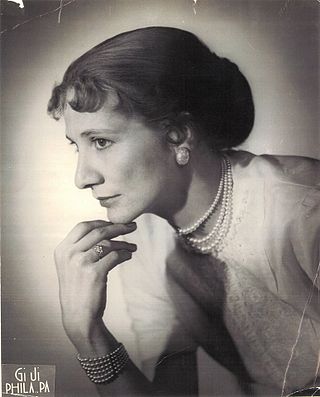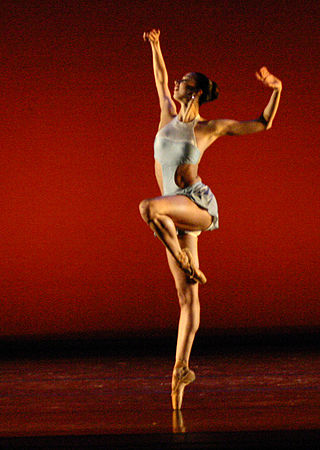
American Ballet Theatre (ABT) is a classical ballet company based in New York City. Founded in 1939 by Lucia Chase and Richard Pleasant, it is recognized as one of the world's leading classical ballet companies. Through 2019, it had an annual eight-week season at the Metropolitan Opera House in the spring and a shorter season at the David H. Koch Theater in the fall; the company tours around the world the rest of the year. The company was scheduled to have a 5-week spring season at the MET preceded by a 2-week season at the Koch Theater beginning in 2020. ABT is the parent company of the American Ballet Theatre Jacqueline Kennedy Onassis School, and was recognized as "America's National Ballet Company" in 2006 by the United States Congress.

Katherine Mary Dunham was an American dancer, choreographer, anthropologist, and social activist. Dunham had one of the most successful dance careers of the 20th century, and directed her own dance company for many years. She has been called the "matriarch and queen mother of black dance."

Janet Collins was an African American ballet dancer, choreographer, and teacher. She performed on Broadway, in films, and appeared frequently on television. She was among the pioneers of black ballet dancing, one of the few classically trained Black dancers of her generation.
John Taras was an American ballet master, repetiteur, and choreographer.
Talley Beatty was born in Cedar Grove, Louisiana, a section of Shreveport, but grew up in Chicago, Illinois. He is considered one of the greatest of African American choreographers, and also bears the titles dancer, doctor, and dance company director. After studying under Katherine Dunham and Martha Graham, Beatty went on do solo work and choreograph his own works which center on the social issues, experiences, and everyday life of African Americans. Beatty and his technique and style of dancing were both praised and criticized by critics and dancers of his day.

Misty Danielle Copeland is an American ballet dancer for American Ballet Theatre (ABT), one of the three leading classical ballet companies in the United States. On June 30, 2015, Copeland became the first African American woman to be promoted to principal dancer in ABT's 75-year history.
Nora Koito Kimball-Mentzos or simply Nora Kimball is a ballet teacher and former American ballerina, who is often overlooked for being one of the first African American female soloists—the second -- [at American Ballet Theatre (ABT). She danced with the ABT in the mid-1980s and as an African American who is also Asian American, preceded Misty Copeland, who is often credited as the first. ABT has been described as one of the three great American-style classical ballet companies on the world stage today.

Marion Durham Cuyjet was a pioneer in dance education in Black Philadelphia.
Anne Benna Sims was the first African-American danseuse at American Ballet Theatre and the first African-American soloist in the company's history. Sims' professional career began with Les Grands Ballets Canadiens where she danced in the corps de ballet. In 1972 she was invited to join the Geneva Opera Ballet by company director Alfonso Cata, who became her mentor. When Cata assumed the director position of the Frankfurt Opera Ballet, he offered Sims a position as a soloist. One year later, Sims became a principal dancer. In 1977, Sims returned to the United States and joined the Eglevsky Ballet Company as a principal dancer. In 1978, she performed in Ballet on Broadway. Sims, who joined American Ballet Theatre in late 1978, became the first African American female to hold a contract with the ABT company.

Anne Raven Wilkinson was an American dancer who is credited with having been the first African-American woman to dance for a major classical ballet company. Wilkinson broke the color barrier in 1955 when she signed a contract to dance full-time with the Ballet Russe de Monte Carlo. She was promoted to soloist during her second season with the troupe, and remained with the company for six years. Wilkinson later became a mentor to American Ballet Theatre principal dancer Misty Copeland.

Stella Abrera is a Filipina-American ballet dancer. She danced as a principal dancer with American Ballet Theatre until her retirement in 2020, and is the company's first Filipina principal ballerina. She is now the artistic director of the dance cultural park Kaatsbaan.
Aminah L. Ahmad, formerly known professionally as Llanchie Stevenson, is an American ballet dancer who was the first African-American dancer at Radio City Music Hall Ballet Company, the first African-American female dancer at the National Ballet of Washington, and an original company member and former principal dancer with Dance Theatre of Harlem. She retired from dancing upon her conversion to Islam.
Karel Shook was an American ballet master, choreographer and writer. He was asked to join the Dance Theatre of Harlem. The Dance Theater of Harlem was formed by Arthur Mitchell, Cicely Tyson and Brock Peters.

Skylar Paley Brandt is an American ballet dancer who is currently a principal dancer with the American Ballet Theatre.

Alicia Graf Mack is an American dancer and teacher. She danced with Dance Theatre of Harlem and Alvin Ailey American Dance Theater, and taught at Washington University in St. Louis, Webster University, and University of Houston. As the youngest and first Black Dean and Director of the Dance Division at Juilliard School, a position she attained in 2018, she has been credited with "remaking Juilliard Dance."

Ingrid Silva is a Brazilian ballet dancer who currently performs with the Dance Theatre of Harlem in New York City.

Calvin Royal III is an American ballet dancer. He is the third black dancer to be a principal dancer with the American Ballet Theatre.
Discrimination in dance refers to unequal treatment of performance artists based on white dominant culturally desired symmetry and unified lines.










